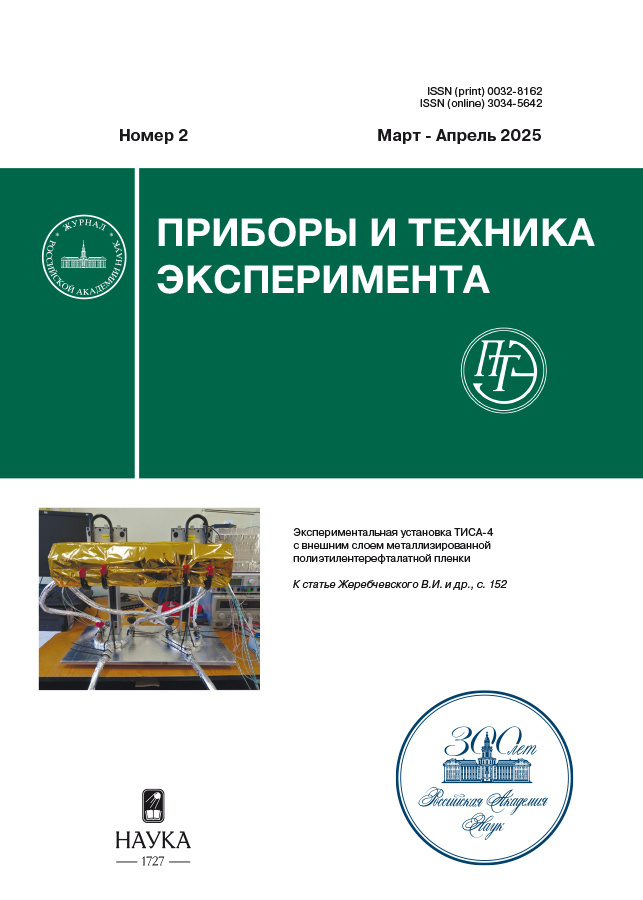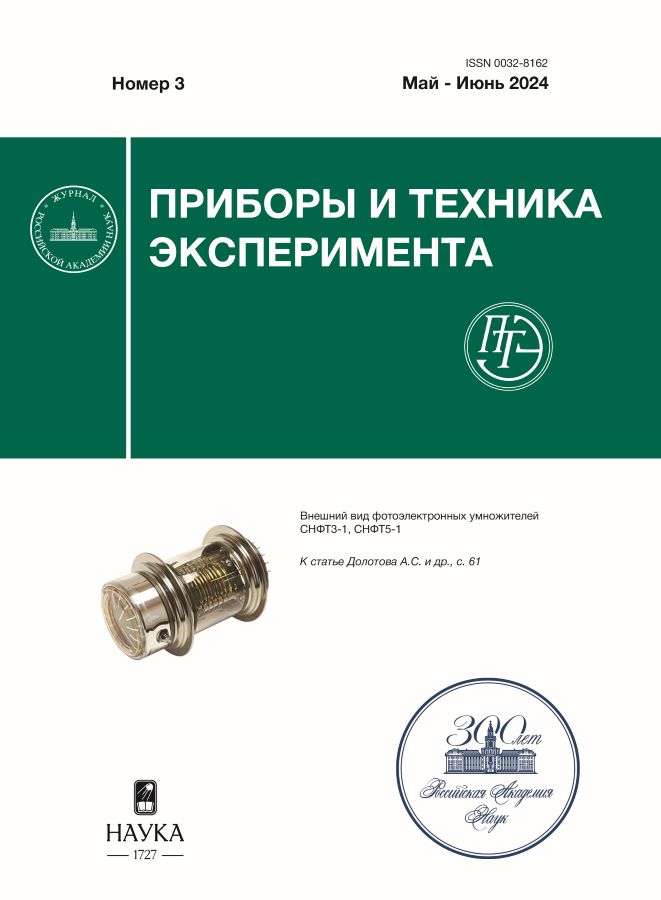Эффективный газовый ионный источник с объемным зарядом
- Авторы: Гусев Ю.И.1, Нечипоренко Ю.В.1, Новиков Ю.Н.1, Попов А.В.1, Соснов Д.Е.1
-
Учреждения:
- Петербургский институт ядерной физики им. Б. П. Константинова Национального исследовательского центра “Курчатовский институт”
- Выпуск: № 3 (2024)
- Страницы: 54-60
- Раздел: ОБЩАЯ ЭКСПЕРИМЕНТАЛЬНАЯ ТЕХНИКА
- URL: https://freezetech.ru/0032-8162/article/view/682613
- DOI: https://doi.org/10.31857/S0032816224030065
- EDN: https://elibrary.ru/OVTNYU
- ID: 682613
Цитировать
Полный текст
Аннотация
Характеристики ионного источника с газовым наполнением и инжекцией электронов были изучены в рамках разработки генератора ионов изомерного состояния 229mTh. Проведены расчеты распределения электрического потенциала и плотности электронов в среде гелия. Измерена эффективность эвакуации ионов. Созданная методика отличается высокими эффективностью и быстродействием в сочетании с возможностью формирования интенсивного пучка ионов продуктов радиоактивного распада и ядерных реакций.
Полный текст
Об авторах
Ю. И. Гусев
Петербургский институт ядерной физики им. Б. П. Константинова Национального исследовательского центра “Курчатовский институт”
Email: popov_av@pnpi.nrcki.ru
Россия, 188300, Гатчина, Ленинградская обл., мкр. Орлова роща, 1
Ю. В. Нечипоренко
Петербургский институт ядерной физики им. Б. П. Константинова Национального исследовательского центра “Курчатовский институт”
Email: popov_av@pnpi.nrcki.ru
Россия, 188300, Гатчина, Ленинградская обл., мкр. Орлова роща, 1
Ю. Н. Новиков
Петербургский институт ядерной физики им. Б. П. Константинова Национального исследовательского центра “Курчатовский институт”
Email: popov_av@pnpi.nrcki.ru
Россия, 188300, Гатчина, Ленинградская обл., мкр. Орлова роща, 1
А. В. Попов
Петербургский институт ядерной физики им. Б. П. Константинова Национального исследовательского центра “Курчатовский институт”
Автор, ответственный за переписку.
Email: popov_av@pnpi.nrcki.ru
Россия, 188300, Гатчина, Ленинградская обл., мкр. Орлова роща, 1
Д. Е. Соснов
Петербургский институт ядерной физики им. Б. П. Константинова Национального исследовательского центра “Курчатовский институт”
Email: popov_av@pnpi.nrcki.ru
Россия, 188300, Гатчина, Ленинградская обл., мкр. Орлова роща, 1
Список литературы
- Moore I.D., Dendooven P., Arje J. // Hyperfine Interact. 2014. V. 223. P. 17. https://doi.org/10.1007/s10751-013-0871-0
- Tordoff B., Eronen T., Elomaa V.V., Gulick S., Hager U., Karvonen P., Kessler T., Lee J., Moore I., Popov A., Rahaman S., Rinta-Antila S., Sonoda T., Aysto J. // Nucl. Instr. Meth. Phys Res. 2006. V. 252. P. 347. https://doi.org/10.1016/j.nimb.2006.08.015
- Beraud R., Canchel G., Emsallem A., Dendooven P., Huikari J., Huang W., Wang Y., Perajarvi K., Rinta-Antila S., Jokinen A., Kolhinen V.S., Niemenen A., Penttila H., Szeripo J., Aysto J., Bruyneel B., Popov A. // Hyperfine Interactions. 2001. V. 132. P. 485. https://doi.org/10.1023/A:1011979029056
- Takamine A., Wada M., Ishida Y., Nakamura T., Okada K., Yamazaki Y., Kambara T., Kanai Y., Kojima T.M., Nakai Y., Oshima N., Yoshida A., Kubo T., Ohtani S., Noda K., Katayama I., Hostain P., Varentsov V., Wollnik H. // Rev. Sci. Instr. 2005. V. 76. P. 103503. https://doi.org/10.1063/1.2090290
- Ringle R., Bollen G., Lund K., Nicoloff C., Schwarz S., Sumithrarachchi C.S., Villari A.C.C. // Nucl. Instr. Meth. Phys Res. 2021. V. 496. P. 61. https://doi.org/10.1016/j.nimb.2021.03.020
- Peik E., Tamm Chr. // Europhys. Lett. 2003. V. 61. P. 181. https://doi.org/10.1209/epl/i2003-00210-x
- Karpeshin F.F., Trzhaskovskaya M.B. // Nucl. Phys. A. 2018. V 969. P. 173. https://doi.org/10.1016/j.nuclphysa.2017.10.003
- Карпешин Ф.Ф. // ЭЧАЯ. 2006. Т. 37. № 2. С. 522
- Витушкин Л.Ф., Гусев Ю.И., Карпешин Ф.Ф., Новиков Ю.Н., Орлов О., Охапкин М.В., Попов А.В., Тржасковская М.Б. // Законодательная и прикладная метрология. 2022. № 3(177). С. 9.
- Sonnenschein V., Moore I.D., Raeder S., Hakimi A., Popov A., Wendt K. // Eur. Phys. J. A. 2012. V. 48(4). P. 52. https://doi.org/10.1140/epja/i2012-12052-3
- Von der Wense L., Seiferle B., Laatiaoui M., Neumayr J.B., Maier H.-J., Wirth H.-F., Mokry C., Runke J., Eberhardt K., Düllmann C.E., Trautmann N.G., Thirolf P.G. // Nature. 2016. V. 47. P. 533. https://doi.org/10.1038/nature17669
- Von der Wense L., Seiferle B. // Eur. Phys. J. 2020. V. 56. P. 277. https://doi.org/10.1140/epja/s10050-020-00263-0
- Karpeshin F.F., Trzhaskovskaya M.B. // Nucl. Phys. 2021. V. 1010. P. 122173. https://doi.org/10.1016/j.nuclphysa.2021.122173
- Moore I.D., Kessler T., Sonoda T., Kudryavstev Y., Perajarvi K., Popov A., Wendt K.D.A., Aysto J. // Nucl. Instr. Meth. Phys. Res. B. 2010. V. 268(6). Р. 657. https://doi.org/10.1016/j.nimb.2009.12.001
- Попов А.В. Свидетельство о гос. регистрации программ 2018617922. 2018.
- Гусев Ю.И., Новиков Ю.Н., Попов А.В., Тихонов В.И. // Изв. РАН. серия физическая. 2016. Т. 80(8). С. 962. https://doi.org/10.7868/S0367676516080184
- Huikari J., Dendooven P., Jokinen A., Nieminen A., Penttila H., Perajarvi K., Popov A., Rinta-Antila S., Aysto J. // Nucl. Instr. Meth. Phys. Res. B. 2004. V. 222(3-4). Р. 632. https://doi.org/10.1016/j.nimb.2004.04.164
Дополнительные файлы


















